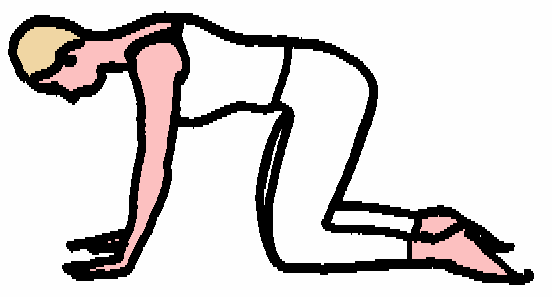|
|
|---|
Rest Position:- Start Position
- Kneel in the quadriped position with knees separated 40 cm, and the
feet the same distance apart.
- Apply the scapular anchor.
Rest Position:- Action
- (Keeping your weight equal over your hands and knees): Lean backward until your
buttocks are resting on or between your feet. Rest your forehead on the ground.
- Lift you head and glance between your feet to check that your body is centered
between your feet. Once you are sure that your body is in perfect symetry, place
your forehead back on the ground.
- Feel the stretch over the shins and the front of the ankles.
- Relax and breathe deeply. Feel the back of your rib cage expand as you
breathe.
Coming out of the Rest Position:- Action
- Zip and hollow and firmly apply the scapular anchor.
- Press down on your hands and ankles and use your gluteal muscles to rise up
into the quadriped position.
(Scroll right>>>>....)
|
Rest Position:
Start (Quadriped) Position

Action

Comments
This exercise can be used two different ways:
- Going into and coming out of the rest position.
- Resting in perfect alignment while in the rest position
We suggest you repeat the Rest Position four to 8 times without pause, and then the last time,
remain "praying" for ten breaths or longer.
© Bruce Thomson, EasyVigour Project
scroll up^^^^.....
|
What it does
- Going into and coming up out of the Rest Position challenges the scapular anchor muscles to
function when being used in a way that they are not usually
used, and this will help provide protection from injury.
- Rebalances muscle tension around the hips (see watch point below).
- The Rest Position stretches the gluteal muscles and the ligaments over
the base of your back and sacrum: very relaxing!
- It also stretches the shin muscles and
their covering, and can thus help with anterior compartment syndrome and
shin splints.
|
Watch Point
- Don't let your rear end skew to the side!
For example, the person in the diagram to the right has tight muscles in the left
buttock, this can be corrected with the help of an observant friend.
|

|
|
Reference
- Shirley A Sahrmann: Diagnosis and Treatment of Movement Impairment Syndromes;
Publ. Mosby 2002
- The Official Body Control Pilates Manual Available from: http://www.bodycontrol.co.uk/
|
|



